Time After Time Spiral
This is my last column about Time Spiral Remastered, so I thought I would share a bunch of stories about how some of these cards originally got designed.
Crovax, Ascendant Hero; Mirri the Cursed; and Keen Sense
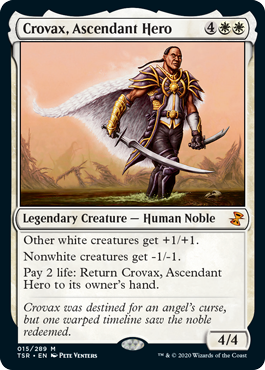
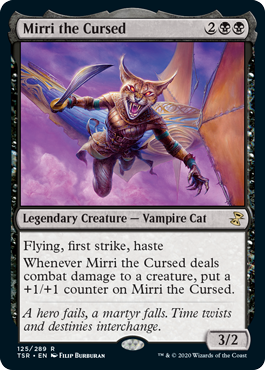
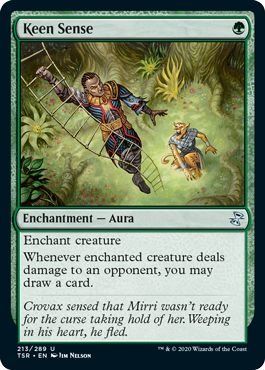
Planar Chaos was the "alternate-reality present set." The majority of the focus went to the alternate version of the color pie, but the set also dipped its toe into some other types of alternate-reality fun. For example, these three cards represent an alternate reality of a key story moment from the Weatherlight Saga. While breaking into Volrath's Stronghold to rescue Sisay, Karn, Tahngarth, and Takara (Starke's daughter), the Weatherlight crew runs into Selenia, Dark Angel. Selenia is an angel that was part of a cursed artifact owned by Crovax's family. Crovax fell in love with Selenia and freed her from the artifact only to have her instantly abandon him.
We find out that Selenia traveled to Rath when she and Gerrard have an interaction after he falls off the Weatherlight. In Volrath's Stronghold, Selenia attacks Crovax, intent on killing him. Mirri intervenes and is greatly injured. To save Mirri, Crovax is forced to kill Selenia, an act which curses him to vampirism. What if, however, Mirri had been successful when she first attacked Selenia and had been the one to strike her down, thus cursing Mirri to vampirism?
Crovax, Ascendant Hero shows what would have become of Crovax as a result of this change. Watching Mirri fall victim to something that he took responsibility for pushes Crovax to become a hero and try to atone for the mistakes in his life. He becomes a leader of the good and hunter of the evil. The life payment cost of his last ability hints at his mono-black origins.
Mirri the Cursed shows what would have become of Mirri if she had become a Vampire. Instead of a 2/3, she becomes a 3/2. She keeps first strike but swaps forestwalk and vigilance for flying and haste. She also gains a Vampire ability similar (but not exactly the same) to Sengir Vampire from Alpha.
Keen Sense was a colorshifted Curiosity. Curiosity first appeared in Exodus and shows the story point where an injured Mirri follows Crovax off the Weatherlight. It would lead to the encounter where Crovax kills Mirri and leaves the Weatherlight. Keen Sense shows their interaction, but the story point has changed. Crovax is now boarding the Weatherlight having to leave the cursed Mirri behind.
Damnation
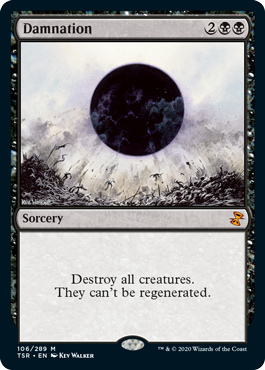
While I've told bits and pieces of Damnation's design story over the years, I haven't ever told the full story. It's a good example of how necessity is the mother of invention. This story starts early in Time Spiral's design. I took over as head designer in the middle of Champions of Kamigawa block. That block was already in full swing, so I gave notes to the Betrayers of Kamigawa and Saviors of Kamigawa design teams, but I didn't make any major change to the block structure. Original Ravnica would be my first chance to oversee a block from the beginning.
One of the things I was interested in starting was true block design. Up to that point, we'd designed the first large set of the block and just let the teams that followed do whatever they wanted that made sense with what the sets before them did. We would often leave some design evolution on our named mechanics and occasionally plan a little more (saving enemy two-color combinations for Apocalypse, balancing the colors in Judgment to offset Torment, etc.), but there was never full planning ahead of time. I wanted to change that.
Ravnica block introduced what I called a pie model. The full block was one entity, and we chopped it into three parts. When you saw the first part, you understood what parts were missing. For Time Spiral block, I was interested in trying something different, what I called a motif model. Each set would have its own theme, but the themes would click together to make a large cohesive motif for the block. For Time Spiral block, I eventually settled on the motif being time. How do you chop up time into three themes? It seemed obvious—past, present, and future.
While that sounded cool, it got a lot messier when you started examining execution. The past set made sense—repeat old cards, make cards that remind you of old cards, create cards of things from Magic's past that didn't have a card yet, just do things that recalled Magic's past. The present and the future were much more daunting. Wasn't every set the present? And what would a future set do? Obviously, it would show you brand-new things you've never seen before. But doesn't every set do that?
The key to solving this puzzle was realizing that the block had a theme in addition to time—nostalgia. Was there a way to harness nostalgia to tell past, present, and future? Again, past was easy. Future could harness nostalgia by taking game elements that exist and using them in new ways, whether that be combining them, extrapolating them, or just using them as jumping-off points for new design space. The big question was how do we use nostalgia to sell the present?
The answer came from Back to the Future Part II. For those unaware, I'm a huge fan of time travel movies. I started thinking about the Back to the Future trilogy, thinking about how they used the past, present, and future. In the first movie, the present was just a bookend to the story. It was the home that the hero wants to return to. It was Marty McFly's version of Dorothy's Kansas from the Wizard of Oz. In the second movie, they made more interesting use of it. (For those who haven't yet seen the Back to the Future trilogy, you may want to stop reading here and go watch it. I'll wait.) Marty goes to the future and purchases a sports almanac containing the results of major sporting events from 1950 to 2000. Future elderly Biff, the bad guy, finds the almanac and steals the time machine to give the almanac to his younger self. When Marty gets back to the preset, it has been changed by Biff's actions. That was my answer—alternate reality. It wouldn't just be the present, it would be an alternate-reality present.
I was very excited because it had been a tricky puzzle to solve. There was one small problem. No one else got it. When I would say "alternate-reality present," people's eyes would just glaze over. It didn't mean anything to them. The biggest problem was that I had planned on having Bill Rose lead Planar Chaos, and he turned me down, specifically because he didn't get the premise for the set. I was going to lead Future Sight, which would overlap with Planar Chaos, so I couldn't lead both. I really needed Bill to say yes. That meant I had to figure out some way to get Bill to see my vision.
In the past, I'd found that designing cards was key to helping people understand my vision. Seeing unfulfilled potential is difficult. Actual cards grounded the idea into a workable, tangible reality. If I wanted to get Bill on board, I had to make some Planar Chaos cards. So, I thought long and hard about the easiest way to convey what I wanted. The key to my concept rested on the color pie. In this alternate reality, the color pie was executed differently. The colors still all had their same philosophies (this was important because alternate reality has to be grounded in something—you can't change everything), but which mechanics we'd chosen to represent those philosophies had changed. The simplest way to convey this was to take some known famous Magic cards and redo them in a different color.
The big question for me was what cards do I change? I knew I didn't need a lot, just a handful, but something that would get the idea to click with Bill. So, what I did was take one of the Magic encyclopedias (this was before online databases were as ubiquitous as they are now) and made a list of iconic cards. I then asked myself, could this effect make sense in a second color? This didn't work well for a lot of cards, but a few just clicked. One of them was Wrath of God. Is there a color other than white that's good at killing lots of creatures? Yeah, black. If black could kill target creature, why not all creatures? Yes, white's better at that, but if we're going to an alternate reality, it wasn't a big stretch to imagine it could have been black.
It turns out my plan worked beautifully. Colorshifting classic Magic cards got Bill to see what I meant, and Damnation and the white Memory Lapse that didn't make it to print were the two cards that really got him on board. Realizing how potent Damnation was to sell the idea, I was the one who pushed for it to be our Day 0 reveal on the website. When you showed up to DailyMTG.com that day, you would see the normal website melt away as Wrath of God formed on the screen. It then transformed into Damnation. And just like I had done with Bill, I used Damnation to sell the world on "alternate-reality present."
Firemaw Kavu
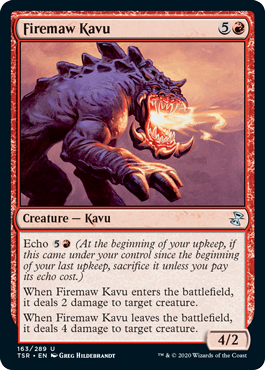
I talk a lot about Vorthos design, how we take a cool, flavorful, resonant thing and build a card around it. What I talk a lot less about is Mel design, that is, design created to capture the richness of what you can do with game mechanics. A great Mel design is a design that shows off what you can accomplish with clever use of your mechanics. Firemaw Kavu is a great example of this.
The design started with us wanting to do a riff on Flametongue Kavu, a popular uncommon creature from Planeshift.
The original is a 4/2 with an enters-the-battlefield trigger that deals 4 damage to a creature. That meant we probably wanted a 4/2 that also entered and dealt damage to a creature. This was Time Spiral, so we had access to old keyword mechanics. Was there a keyword that interacted well with enters-the-battlefield effects? There were a few, but the one that stood out for me was echo.
Echo was originally designed by Mike Elliott for a homemade set he'd made called Astral Ways. When Mike was hired by Wizards, they bought his set. Astral Ways had three main mechanics: Slivers, astral, and planeshift. All three mechanics were put into Tempest during design, but only Slivers and astral (renamed shadow) would stay in. Planeshift (later renamed echo) was put in the large set a year later, Urza's Saga, for which Mike led the design. One of the things I was very interested in about echo when I worked on the three sets in the Urza's Saga block was how echo interacted with enters-the-battlefield and death triggers. It became a major theme in both Urza's Legacy and Urza's Destiny. (If you're interested in hearing more about the history of echo, feel free to check out my column from Echo Week back in 2007.)
The new Kavu could clearly have echo and an enters-the-battlefield creature damage effect, but I was interested in something a little more complex. What if the card had an enters-the-battlefield damage effect and a death-trigger damage effect. That way, you could decide if the body was important to you or not. If not, you got to deal damage to two different creatures over two turns and you got a 4/2 blocker for one attack. If you did want the body, you got a Shock and a 4/2 that no one wants to block (and kill). The first version of the card dealt 4 damage when it entered and 2 damage when it died to mirror the creature's 4/2 stats (and more closely match Flametongue Kavu), but then came the fun Mel moment. I realized that if I swapped the two, it added another interesting mode to the card. When Firemaw Kavu entered the battlefield, you could choose to have it deal 2 to itself which would immediately trigger the death trigger, meaning if you really needed to deal 4 damage to a creature the turn you cast it, you could. That tickled me to no end. I believe I turned in the card with the name Clever Kavu.
The Pacts
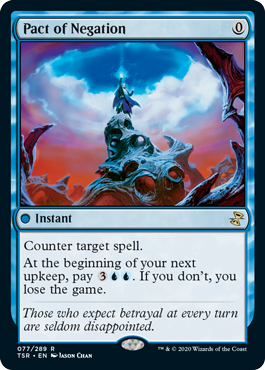

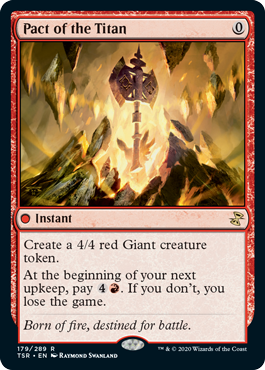
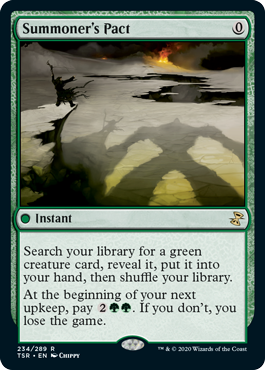
For those who are somehow unaware, the Un- sets (Unglued, Unhinged, and Unstable plus Unsanctioned) are my babies. Over the years, I've often been called on to defend them, and one of the arguments I always use is that they're a great testing ground for the future. For example, full-art lands, creature tokens, split cards, and the meld mechanic were all byproducts of things first made in Un- sets. The Pact cycle is another example (and yes, this was a full cycle in Future Sight, but the white one, Intervention Pact, was deemed unworthy to reprint in Time Spiral Remastered).
The card that inspired this cycle was a card called Rocket-Powered Turbo Slug in Unhinged.
One of the things I like to do in Un- sets is take normal Magic mechanics and tweak them. One day, I got it into my head that it would be fun to have a mechanic called super haste. What exactly would that do? Well, it had to be like haste, but better. How do you make something better than haste? What if instead of attacking with a creature the turn you played it, you could attack the turn before you played it? That sounded awesome, but how exactly does one do something a turn earlier than you take an action? I explored somehow turning the game back. Too complicated. I explored having the creature deal damage to the opponent equal to its power when it entered the battlefield. Too boring. Black-border Magic could do that. That's when I found my answer. What if instead of attacking last turn, you paid for it next turn? The last question to answer was what would happen to you if you didn't pay? I just wanted to keep it simple, so I said you lost the game. You have to pay for it next turn. There's no alternative.
Flash forward a number of years, and we're working on Planar Chaos. One of the team members, Paul Sottosanti, pitched an idea. What if in the alternate reality, Rocket-Powered Turbo Slug's mechanic was in black border? It wouldn't be called super haste, but it could definitely have the "it's free this turn, but you have to pay for it next turn" mechanic. Paul had talked with the rules manager and was told it could work in the black-border rules, so he made a cycle of cards. As Rocket-Powered Turbo Slug's creator, I was obviously a fan of the idea, but I had one suggestion. Paying for spells next turn didn't feel like alternate-reality present, it felt like the future, so I moved the cycle to Future Sight.
Interestingly, we tried a slightly different version of this mechanic before reverting back to something much closer to Rocket-Powered Turbo Slug:
Deep Denial
3UU
Enchantment
Surprise echo – 3UU (You may choose to play this card for 0. If you do, the card gains echo.)
When CARDNAME comes into play, counter target spell. If CARDNAME is put into the graveyard from play without its echo cost having been paid, remove your library from the game.
The problem with this version was that any kind of enchantment removal basically meant a game loss for its caster. We then reverted to the text you see now. We did talk a bit about having a drawback less severe than losing the game, but playtesting showed that players just built their decks to avoid having to pay and that really wasn't the point of the cards, so we ended up just making the drawback for not paying lose the game.
Urza's Factory
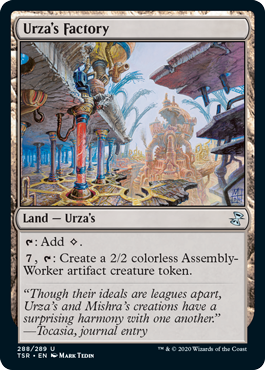
Antiquities was the first Magic expansion to have a mechanical theme. (Arabian Nights was the first to have a top-down flavor theme.) Every nonland in the set had the word "artifact" or "artifacts" in its rules text or card type. All the lands tapped for colorless mana (and a couple did have the word "artifact" in their rules text). One of the fan favorites of the lands were three lands known colloquially as the Urzatron.
The idea was that if you got all three in play together, instead of producing three colorless mana, they produce seven. Years later, in order to make the cards work under modern templating, they were given subtypes that matched their name. This meant all of them had the subtype Urza's.
When we were designing Time Spiral, we thought it would be fun to make a fourth land with the subtype Urza's. Obviously, we wanted it to play nicely with the Urzatron. The big question was how do we do that? We knew it should tap for a colorless mana, but it needed to have some other ability. What if it also produced more mana if you had the other three? That seemed kind of boring. We tried a couple different things until we hit upon the cleanest answer—give it an activated ability for seven mana. When the Urzatron is on, this card does something cool.
This led to the next question. What cool and flavorful thing could we do for seven mana? We looked at all of Urza's cards trying to find some connection. Nothing seemed to leap out at us. Then we took a look at Antiquities. It turns out the set had another very iconic land—Mishra's Factory. (To be fair, all six lands from the set turned out to be pretty iconic.) Mishra's Factory could turn into a 2/2 artifact creature called an Assembly-Worker. We'd already made a card called Assembly-Worker that basically functioned like Mishra's Factory (it was a 2/2 that could grant +1/+1 to Assembly-Workers.) What if we tied Urza's Factory to Mishra's Factory and had it also make Assembly-Workers? The brothers had a history of copying one another in their inventions, so we thought it would be a cool callout. You'll note the flavor text helps reinforce this point.
Time's Up
That's all the time I have for today. I hope you enjoyed my stories. As always, I'm eager to hear any feedback on this column, the cards I talked about today, or on Time Spiral Remastered itself. You can email me or contact me through any of my social media accounts (Twitter, Tumblr, Instagram, and TikTok).
Join me next week for this year's "Nuts & Bolts."
Until then, may you have a good time with Time Spiral Remastered.
#815: Trivia – Longest Names
#815: Trivia – Longest Names
31:31
This is another of my trivia podcasts where you try to guess the card I'm talking about before I reveal it. The topic? The longest names in Magic. (This is a companion to my shortest names trivia podcast last week.)
#816: Innistrad with Erik Lauer
#816: Innistrad with Erik Lauer
32:36
I was the lead designer for original Innistrad, and Erik was the lead developer. I have Erik on my podcast to talk about the making of the set.
- Episode 814 Trivia – Shortest Names
- Episode 813 TSP with Aaron Forsythe
- Episode 812 Timeshifted Sheets

